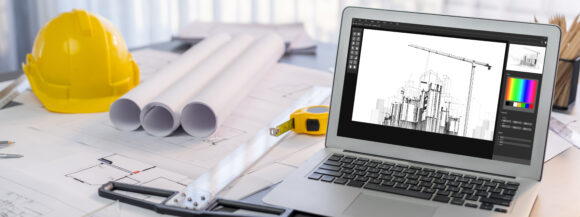Technology has revolutionized the architecture and engineering (A&E) design space over the past 40 to 50 years, allowing for improved efficiency and faster architectural design and output.
However, these technological advances can also increase the chance for error — or in insurance terms, exposure to loss. In addition to compressing the work schedule, the quality of the data generated may also be reduced. The cumulative effect can be even more project errors. We all know the saying: Garbage in, garbage out.
In the early 1980s, AutoCAD digitized architectural drawing. More recent uber-sophisticated tools such as building information modeling (BIM)
or integrated project delivery (IPD) have provided efficiencies and opportunities in the architecture and engineering fields that were unavailable even a few decades ago.
While these powerful software programs have trans- formed the design space, there are fewer than a half-dozen providers of that software, with just two who dominate the market. Those entering the field with architecture or engineering degrees are quite familiar with those two tools, sometimes relying on them almost exclusively.
For insurers, that’s a problem.
Increasing A&E Claims
Today’s A&E designers are skilled at using advanced technology but often don’t understand how a structure comes together as well as they should. They are computer-savvy, but the pencil-to-pa- per calculations employed by yesterday’s designers are not their forte. It’s not how they were trained. Instead, their designs often originate from templates on a computer rather than real-world design, where the architects and engineers actually see the brick-and-mortar realities of construction.
As a result, insurers are seeing a lot more claims related to quality control than in the past. The plan-checking oversight that was standard during the days when pencils, rulers, protractors — and mathematically trained brains — were their primary tools has been deemphasized since technology has become the primary design mechanism.
Insurers and brokers face a similar challenge as they try to stay on top of professional liability exposures from the A&E industry.
Whereas insurers once had a pretty good handle on the safety net that architects and engineers needed, technology and tools such as AI are now developing so quickly that it’s not always clear how that A&E risk safety net should be constructed.
A recent case example demonstrates the issue: During the design phase, a designer decided to change one type of fastener for joints in a building’s plans. The substituted fastener was one-half millimeter different in length than the original. When the number of fasteners needed was multiplied by one-half millimeter throughout the 30,000-square-foot warehouse, the building envelope could no longer close properly.
A simple switch to a discrete piece of data in a software program caused a substantial impact to the physical space, which no one caught until on-site construction was underway. It was a basic error that required a very expensive fix.
More Risk Complications
The emergence of AI as a technological tool and an increasing use of drones on work sites have only added to the challenges insurers and their clients face in the A&E space.
Drones are a mixed blessing with obvious privacy issues. As an extra set of eyes, so to speak, they make it much quicker to survey project sites and catch any problems. But they also can cause architects and engineers to be legally responsible for identifying safety and privacy issues that in the past they would not have been — nor should be — responsible for.
It’s a delicate balance, and one insurers examine daily. We must properly document what A&E designers are or are not responsible for. And we must work with A&E designers to ensure they understand and mitigate their exposures.
Even when sophisticated 3D models are used, changes can be made on the fly without fully measuring their impact. For example, on another project a designer needed to tighten the space between floors, but without the appropriate degree of quality control, they did not realize the HVAC venting would no longer fit in the
condensed area. This resulted in an insurance claim.
These situations follow a similar pattern, and they underline the challenge of implementing technology to expedite and improve a project and its quality while still insuring it properly.
We’re still in the early stages of integrating generative AI applications such as ChatGPT, but the expectation is it will allow that flow of information and requisite analyses to be done at much higher speeds than ever before, which is a concern.
We know the use of advanced technology can get a project from A to Z quicker, but not always with the context necessary to avoid risk and, ultimately, claims.
Quality Control Is Imperative
It’s easy to click a button to substitute one part for another throughout a design. But how can the designer determine that it’s the right substitution? Will a seemingly inconsequential change end up being a big and costly problem?
In order to improve underwriting loss ratios, insurers must study the A&E industry’s rapid changes and develop best practices for risk management, which is an obvious challenge.
Imagine designing a safety net for a trapeze artist act. Everything works fine; however, just before the performance, the act is updated, and now the performers are operating from a moving rail car. That safety net must be redesigned to assure the safety of the artist.
The bottom line is that advancing technology requires advances in quality control, and more technology requires more, not less, quality control. Architects and designers must dedicate enough resources — and appropriately trained experts — to control the quality of their design and in doing so, help their insurers protect them.
And insurers, for their part, must be willing and able to keep up with this ever-changing field so we can adequately respond to the needs of our insureds.
Topics Tech
Was this article valuable?
Here are more articles you may enjoy.



 BlackSuit Cybercrime Gang Blamed in CDK Hack That Roiled Car Dealers
BlackSuit Cybercrime Gang Blamed in CDK Hack That Roiled Car Dealers  Ryan Specialty Announces Succession Plan: Pat Ryan to Exec Chair, Turner to Be CEO
Ryan Specialty Announces Succession Plan: Pat Ryan to Exec Chair, Turner to Be CEO  German Insurtech Wefox to Replace CEO After Board Rejects Mubadala Sales Plan
German Insurtech Wefox to Replace CEO After Board Rejects Mubadala Sales Plan  US Roof Maintenance Lags: Hanover
US Roof Maintenance Lags: Hanover 



